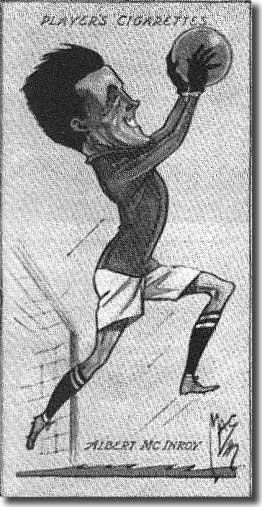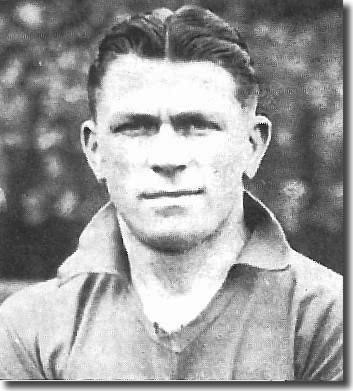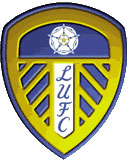 New
Elland Road boss Billy Hampson had
to preside over an end of season fight against relegation
when he joined United in March 1935. Leeds United managed to survive comfortably
enough in the end, but had struggled against teams in the relegation zone
over the last two months of the season. Hampson was inexperienced as a
manager (he had spent five years with lowly Carlisle and Non-League Ashington),
but he had lengthy years of football behind him and he recognised that
changes had to be made to the side.
New
Elland Road boss Billy Hampson had
to preside over an end of season fight against relegation
when he joined United in March 1935. Leeds United managed to survive comfortably
enough in the end, but had struggled against teams in the relegation zone
over the last two months of the season. Hampson was inexperienced as a
manager (he had spent five years with lowly Carlisle and Non-League Ashington),
but he had lengthy years of football behind him and he recognised that
changes had to be made to the side.
During the summer he engineered a major turnover of personnel at the
club. Out went forwards Harry Roper, Bert Worsley, Joe Firth and Johnny
Mahon, keepers John Daniels and Stan Moore, and reserve centre-half Charlie
Turner. He brought in newcomers, mainly from the lower Leagues, in centre
halves Bob Kane and Dominic Kelly and forward Jimmy Carr, but he made
a couple of notable buys in experienced former England internationals
Albert McInroy and George Brown.
Goalkeeper McInroy was 34 years old and had played for Newcastle (winning
the FA Cup in 1932) and Sunderland (in two spells, either side of his
time on Tyneside). Brown was a 32 year old centre forward who had led
the Huddersfield Town attack as they swept all before them during their
dominance of English football in the Twenties. He scored 142 League goals
in eight years at Leeds Road, with 35 of those coming in 1925-26 as Huddersfield
secured the third of their three titles in a row. He had moved on via
Aston Villa to Burnley when Hampson signed him.
Hampson went on signing new players through the autumn: he bought winger
Sammy Armes from Blackpool, a player he had with him at Carlisle; he paid
£1,500 to Derry City of Ireland to secure wing-half Bobby Browne, the
first of a number of young Irishmen he signed for Leeds; and he revisited
Ashington to enlist two of his former charges, centre-forward John Trainor
and 16-year-old full-back Jim Milburn, uniting him with brothers George
and Jack at Elland Road.
A bluff character, Hampson had a reputation for fair dealing, and continued
grooming one of Dick Ray's notable proteges,
right-back Bert Sproston, who had made his debut two seasons earlier and
won the first of 11 England caps in October 1936. Sproston was a versatile,
stylish defender but chronic lack of funds forced Leeds to sell him to
Tottenham in 1938 for £9,500. It was a depressingly familiar story.
George Milburn had now been ousted from the side by the emergence of
Sproston, but brother Jack had a remarkable year. He was now the club's
established penalty taker and had slotted home six the previous year,
but in 1935/36 he contributed an unprecedented 9, including three in successive
games during October.
McInroy was put straight into the team and missed just one match all
season. Willis Edwards was still
Mr Dependable at right-half, but Ernie Hart played only four times, with
Jock McDougall and Bertie Kane competing all season for his No 5 shirt.
Bobby Browne was the regular left-half following his arrival in October
and in the forward line George Brown, Jack Kelly, Billy Furness and Tom
Cochrane were regulars, being variously partnered by any one from Harry
Duggan, Arthur Hydes (injured for much of the season), Sammy Armes, Eric
Stephenson and the outgoing Johnny Mahon and Mick Kelly.
It was goals that were the problem in the early part of the season. Jack
Milburn's first penalty came in the 3-1 opening day defeat at Stoke, and
Hydes was the only other scorer in the first five matches, netting a consolation
during a 4-1 drubbing by Blackburn at Elland Road. The only point from
those five games came in a goalless draw at home to Birmingham, who had
themselves narrowly avoided the drop the previous year. Hydes was injured
in the Blackburn game and only played once more before April.
George Brown came in for Hydes at that point, but was quite slow getting
off the mark, scoring just once in his first seven matches for the club.
Indeed, following the draw with Middlesbrough on October 19, amazingly,
Jack Milburn was the leading scorer with five goals. By now, however,
Leeds were starting to settle down. They had managed a couple of  victories
and were unbeaten for six matches. They beat Aston Villa 4-2 in their
next game with Brown and Jack Kelly getting two apiece. They were starting
to climb away from the basement.
victories
and were unbeaten for six matches. They beat Aston Villa 4-2 in their
next game with Brown and Jack Kelly getting two apiece. They were starting
to climb away from the basement.
The next game, away to Wolves on November 2, saw a 3-0 defeat, but Leeds
then put together another unbeaten spell, this time of six matches, commencing
with a 7-2 romp over Sheffield Wednesday, inspired by a hat trick from
Duggan. Duggan got another in a 5-2 thrashing of Bolton, and Brown was
now finding his form with two in the Bolton win and then one in each of
the next two matches.
United's early season jitters were now well behind them and even two
successive defeats in Christmas week could not halt their rise as they
then won four of the next five League games and started the annual Cup
campaign. They needed a replay to beat Wolves in the third round, but
saw off Bury at the first attempt in the fourth. The FA Cup curse that
seemed to afflict the club continued, though, when they crashed out 3-1
in the fifth round at Second Division Sheffield United. Leeds had reached
the same stage three times in six years, but gone out each time, twice
to opposition from the lower divisions.
Their league form was holding up well, however, and even though they
continued to lose too many matches away from Elland Road, the side were
heading for a comfortable 11th place finish. They were never in the running
for the title (Sunderland romped home by a clear 8 points), but even winning
just one point from their final two matches (which included a 5-0 disaster
at Preston North End) left them six points clear of relegation. If they
had taken maximum points from those last two matches, they would have
finished seventh.
After the gloom of the previous year, it was a heartening improvement
for Hampson in his first full season. Crowds had started to pick up too,
and it was the first time in six years that the average attendance at
Elland Road had bettered 20,000.
Other Football Highlights from 1935/36
- Arsenal centre-forward Ted Drake had a tough time with injury, but
still managed to hit seven goals in one match away to Aston Villa in
December. He also scored the only goal in the Cup final against Sheffield
United to secure the Gunners' sixth trophy in seven years
- Joe Payne went even better than Drake when he hit ten goals in Luton's
12-0 victory over Bristol Rovers in the Third Division South match in
April. Payne was a reserve wing-half and only played up front when Luton's
regular centre-forward and his deputy were injured
- A record league crowd of 82,905 saw Chelsea draw with Arsenal at Stamford
Bridge on 12 October
- Aston Villa and Blackburn Rovers, founder members of the Football
League, were both relegated from Division One for the first time
back to top












 New
Elland Road boss Billy Hampson had
to preside over an end of season fight against relegation
when he joined United in March 1935. Leeds United managed to survive comfortably
enough in the end, but had struggled against teams in the relegation zone
over the last two months of the season. Hampson was inexperienced as a
manager (he had spent five years with lowly Carlisle and Non-League Ashington),
but he had lengthy years of football behind him and he recognised that
changes had to be made to the side.
New
Elland Road boss Billy Hampson had
to preside over an end of season fight against relegation
when he joined United in March 1935. Leeds United managed to survive comfortably
enough in the end, but had struggled against teams in the relegation zone
over the last two months of the season. Hampson was inexperienced as a
manager (he had spent five years with lowly Carlisle and Non-League Ashington),
but he had lengthy years of football behind him and he recognised that
changes had to be made to the side. victories
and were unbeaten for six matches. They beat Aston Villa 4-2 in their
next game with Brown and Jack Kelly getting two apiece. They were starting
to climb away from the basement.
victories
and were unbeaten for six matches. They beat Aston Villa 4-2 in their
next game with Brown and Jack Kelly getting two apiece. They were starting
to climb away from the basement.